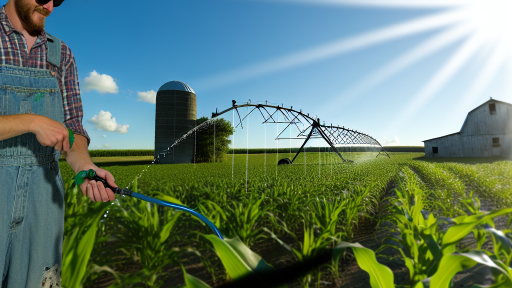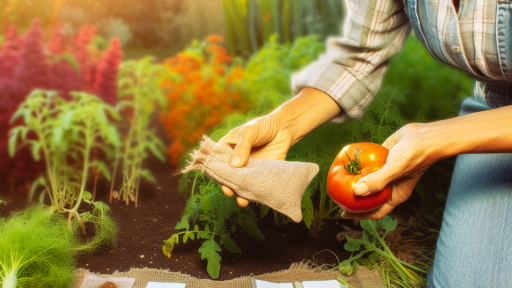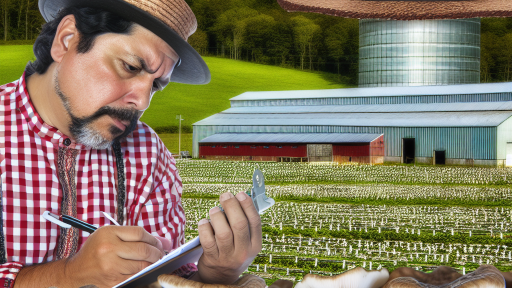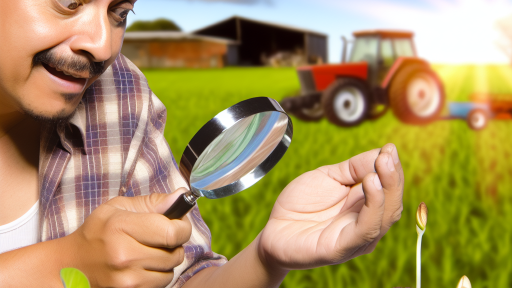Introduction to Seed Saving
Definition of Seed Saving
Seed saving refers to the practice of collecting and storing seeds from plants for future planting.
This process allows gardeners and farmers to cultivate crops that thrive in their specific environments.
Additionally, saving seeds empowers growers to maintain and enhance plant diversity.
Historical Context of Seed Saving
Historically, seed saving has been a fundamental practice in agriculture.
Ancient civilizations relied heavily on seed saving for food security.
Farmers saved seeds from the best-performing plants to ensure better yields in subsequent seasons.
Over time, this practice contributed to the development of diverse heirloom varieties.
The Transition to Modern Agriculture
With industrial agriculture’s rise, seed saving became less common.
Farmers often relied on commercial seed suppliers for uniformity and convenience.
This shift diminished local seed diversity and traditional knowledge about crop management.
Revival of Seed Saving Practices
In recent years, there has been a resurgence in the interest of seed saving.
Many people recognize the importance of biodiversity in maintaining ecosystems.
Community seed banks and local seed exchanges have emerged to promote these practices.
This movement emphasizes sustainable agriculture and self-sufficiency.
Seed Saving in Sustainable Agriculture
Seed saving plays a crucial role in sustainable agriculture.
Transform Your Agribusiness
Unlock your farm's potential with expert advice tailored to your needs. Get actionable steps that drive real results.
Get StartedIt allows farmers to adapt crops to local conditions over time.
As a result, these plants become more resilient to pests and diseases.
Moreover, this practice reduces the dependency on commercial seed companies.
Economic Benefits of Seed Saving for Farmers
Reducing Costs
Seed saving significantly reduces annual seed purchasing costs.
This practice eliminates the need for expensive commercial seeds.
Moreover, farmers can allocate funds to other essential areas.
Increasing Profit Margins
By saving seeds, farmers can enhance their profit margins.
They can sell surplus seeds to other local growers.
This not only boosts income but also supports local economies.
Adapting to Local Conditions
Saving seeds allows farmers to select the best-performing varieties.
They can choose seeds that adapt well to local climates and challenges.
This practice improves crop resilience and yields over time.
Enhancing Biodiversity
Seed saving promotes greater biodiversity on farms.
Diverse crops can lead to improved ecosystem health.
Furthermore, biodiversity helps reduce the risk of total crop failure.
Building Community Networks
Farmers who save seeds often engage in community seed swaps.
This fosters collaboration and knowledge sharing among farmers.
As a result, strong networks form within local agricultural communities.
Long-Term Sustainability
Seed saving contributes to long-term agricultural sustainability.
It ensures that farmers maintain control over their seed supply.
Ultimately, this practice secures their livelihoods for generations.
Environmental Advantages: Biodiversity and Ecosystem Resilience
Biodiversity Enhancement
Seed saving increases the variety of crops grown in any area.
This practice preserves genetic diversity, crucial for resilient ecosystems.
Diverse crops can better withstand pests and diseases.
Showcase Your Farming Business
Publish your professional farming services profile on our blog for a one-time fee of $200 and reach a dedicated audience of farmers and agribusiness owners.
Publish Your ProfileAdditionally, they adapt to changing climate conditions more effectively.
Farmers benefit from greater crop stability and yield.
Soil Health Improvement
Saving seeds promotes the planting of locally adapted varieties.
These varieties often enhance soil health through improved nutrient cycling.
Healthy soil retains moisture better and supports beneficial microorganisms.
Moreover, it reduces erosion and increases overall soil fertility.
Resilience Against Climate Change
Seed saving cultivates crops that can thrive in variable conditions.
These resilient plants help maintain food security in uncertain climates.
Farmers gain the ability to select seeds that endure droughts or floods.
This adaptability allows agricultural systems to withstand extreme weather.
Conservation of Resources
By saving seeds, farmers reduce reliance on commercial seed suppliers.
This decreases the need for chemical inputs and enhances sustainability.
It also lowers production costs, increasing farm profitability.
Moreover, it conserves water and energy used in production cycles.
Promotion of Local Ecosystems
Seed saving encourages the cultivation of native plant varieties.
These plants support local wildlife and maintain ecosystem balance.
By nurturing native species, farmers contribute to biodiversity conservation.
This helps maintain a healthy and resilient landscape.
Find Out More: Low-Maintenance Edible Landscaping Ideas
Cultural Significance and Preservation of Indigenous Varieties
Understanding Indigenous Varieties
Indigenous plant varieties hold immense cultural significance.
They represent the heritage and traditions of local communities.
Farmers have cultivated these varieties for generations.
This cultivation fosters a deep connection to the land.
Many indigenous varieties exhibit resilience to local climates.
This makes them vital for sustainable agriculture.
Enhancing Food Security
Saving seeds of indigenous varieties promotes food security.
These varieties often require less input than commercial options.
This can reduce dependency on external suppliers.
Furthermore, they contribute to a diverse food system.
Diversity in crops can stabilize local food production.
Thus, communities become less vulnerable to climate change.
Promoting Biodiversity
Seed saving contributes to biodiversity preservation.
Indigenous varieties often possess unique genetic traits.
These traits can improve resilience against pests and diseases.
Encouraging variety growth can prevent widespread crop failures.
Moreover, a diverse gene pool supports ecosystem health.
This biodiversity is essential for the sustainability of agriculture.
Empowering Local Communities
Seed saving empowers local communities and farmers.
It allows them to control their agricultural practices.
Communities can maintain their cultural heritage through seed saving.
Showcase Your Farming Business
Publish your professional farming services profile on our blog for a one-time fee of $200 and reach a dedicated audience of farmers and agribusiness owners.
Publish Your ProfileThey pass down knowledge and skills to future generations.
As a result, traditional farming practices endure.
This fosters a sense of pride and identity among farmers.
Facilitating Economic Independence
Seed saving can enhance economic independence for farmers.
By saving seeds, farmers reduce costs associated with purchasing seeds.
This leads to improved livelihoods and economic stability.
Additionally, local varieties can be marketed as specialty products.
This can create new income streams for farmers.
Ultimately, it builds resilient local economies.
Discover More: Organic Techniques for Growing Mushrooms Sustainably
Impact on Soil Health and Sustainable Farming Practices
Enhancing Soil Biodiversity
Seed saving encourages the growth of diverse plant species.
This diversity boosts soil health and promotes beneficial organisms.
Additionally, it creates a resilient ecosystem capable of tackling pests and diseases.
Improving Soil Structure
Saved seeds can adapt to local soil conditions over time.
They contribute to better soil structure and increased nutrient availability.
Consequently, farmers observe improved water retention in their fields.
Reducing Chemical Inputs
Utilizing saved seeds reduces dependency on chemical fertilizers.
These seeds often require fewer synthetic inputs for optimal growth.
As a result, practicing seed saving promotes organic farming methods.
Promoting Crop Rotation
Seed saving encourages farmers to practice crop rotation effectively.
Crop rotation enhances soil fertility and disrupts pest cycles.
This practice ultimately leads to healthier yields and sustainable production.
Building Local Seed Economies
Seed saving fosters local seed exchanges among communities.
These exchanges increase accessibility to diverse seed varieties.
Consequently, communities become more resilient to market fluctuations.
Supporting Resilience to Climate Change
Saved seeds adapt to specific local climates over generations.
Farmers gain access to hardier crops suited for changing conditions.
Ultimately, this practice enhances food security amid environmental changes.
Find Out More: Getting Started with Hydroponic Farming

Seed Saving as a Tool for Climate Adaptation
Enhancing Resilience through Diversity
Seed saving fosters genetic diversity in crops.
This variety strengthens resilience against climate challenges.
Farmers can select seeds from plants that thrive in local conditions.
As a result, they cultivate varieties better suited to changing climates.
Reducing Dependence on External Resources
Seed saving decreases reliance on commercial seed suppliers.
Farmers can grow their seeds year after year.
This practice promotes self-sufficiency in agricultural systems.
Moreover, it reduces costs during challenging economic times.
Promoting Local Adaptation Strategies
Saving seeds encourages farmers to develop local adaptation strategies.
Farmers can select seeds that perform well in their specific environments.
This local focus leads to better adaptation to regional climates.
Showcase Your Farming Business
Publish your professional farming services profile on our blog for a one-time fee of $200 and reach a dedicated audience of farmers and agribusiness owners.
Publish Your ProfileConsequently, farmers can effectively manage their crops in diverse weather conditions.
Maintaining Cultural Heritage
Seed saving preserves traditional agricultural practices.
Farmers pass down knowledge of local seed varieties through generations.
This preservation strengthens community ties and cultural identity.
Furthermore, it promotes sustainable farming practices over time.
Supporting Biodiversity and Ecosystems
Seed saving contributes to the preservation of agrobiodiversity.
Biodiversity supports ecosystem stability and resilience.
Healthy ecosystems, in turn, support sustainable agriculture.
Thus, seed saving plays a crucial role in maintaining environmental balance.
Gain More Insights: Choosing the Right Hydroponic Equipment
Legal Aspects: Seed Sovereignty and Farmer Rights
Understanding Seed Sovereignty
Seed sovereignty refers to the right of farmers to save and exchange seeds.
This concept emphasizes local control over seed production.
Additionally, it protects farmers from corporate dominance.
Seed sovereignty supports biodiversity and local food systems.
Moreover, it encourages the use of traditional seeds.
Farmer Rights in Seed Saving
Farmers have the legal right to save seeds from their harvest.
This practice fosters agricultural independence and resilience.
Furthermore, it allows farmers to adapt crops to their local conditions.
Legislation should protect these rights to promote sustainable agriculture.
Challenges to Seed Sovereignty
Corporate control often threatens seed sovereignty.
Large companies may impose restrictions on seed use.
This situation hinders farmers’ ability to save and share seeds.
A lack of awareness can also undermine farmers’ rights.
Consequently, it is crucial to educate farmers about these issues.
Promoting Farmer Rights
Advocacy groups play a vital role in protecting farmer rights.
They raise awareness about seed sovereignty and related laws.
Moreover, they lobby for stronger protections against corporate overreach.
Collaboration among farmers, NGOs, and policymakers is essential.
Together, they can create a supportive legal framework.
Global Perspectives on Seed Sovereignty
Many countries have established laws supporting seed sovereignty.
These laws often reflect local agricultural practices and traditions.
Examples include Brazil’s Seed Law and India’s Seed Policy.
These policies aim to balance corporate interests and farmer rights.
International movements further encourage seed saving and sharing.
Challenges and Solutions in Implementing Seed Saving Practices
Identifying Common Challenges
Farmers often face several challenges when adopting seed saving practices.
One major obstacle is the lack of knowledge about proper techniques.
Many farmers may not understand the best methods for seed collection and storage.
Additionally, time constraints can impede their ability to save seeds effectively.
Financial limitations can also restrict access to necessary resources.
Furthermore, some farmers may not have reliable information about seed varieties.
Showcase Your Farming Business
Publish your professional farming services profile on our blog for a one-time fee of $200 and reach a dedicated audience of farmers and agribusiness owners.
Publish Your ProfileAddressing Educational Gaps
Education plays a crucial role in overcoming these challenges.
Providing workshops can empower farmers with essential seed saving skills.
Utilizing online platforms can facilitate knowledge sharing among communities.
Networking with local agricultural organizations can also enhance learning opportunities.
Access to resources and guides improves seed saving techniques significantly.
Utilizing Resource Networks
Building a network of seed savers creates a supportive community.
Local exchanges can allow farmers to share and trade seeds effectively.
This practice encourages diversity and the preservation of heritage varieties.
Collaborating with universities can provide research and development support.
Additionally, partnerships with local nonprofits can enhance community outreach.
Implementing Sustainable Practices
Farmers can integrate seed saving into their overall sustainability strategies.
By focusing on native varieties, they can promote local biodiversity.
Employing organic farming techniques can complement seed saving efforts.
Moreover, documenting seed performance can contribute valuable data.
This data can aid in selecting resilient varieties for future planting.
Overcoming Financial Challenges
Financial barriers can be daunting for those interested in seed saving.
Grant programs can provide funding for educational initiatives and resources.
Investing in community share systems allows for pooled resources among farmers.
Furthermore, promoting the sale of heirloom seeds can create a new revenue stream.
Incentives for sustainable practices can also help alleviate costs.
Additional Resources
Farmer seed networks make a limited contribution to agriculture …




